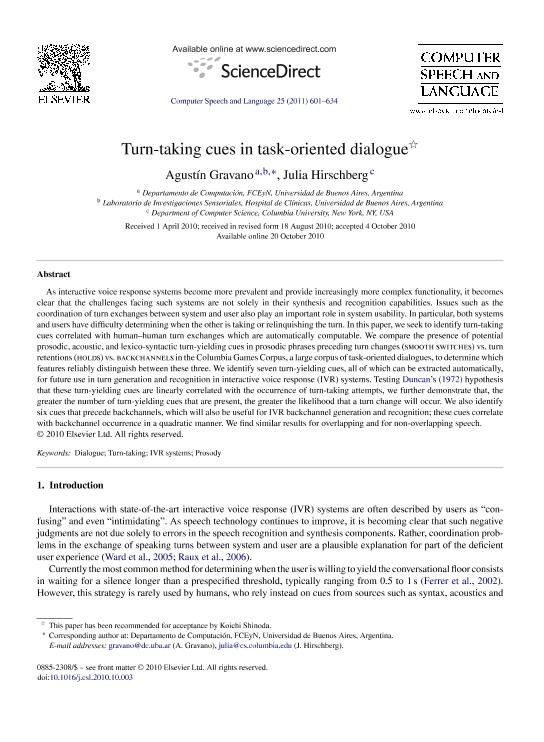Mostrar el registro sencillo del ítem
dc.contributor.author
Gravano, Agustin

dc.contributor.author
Hirschberg, Julia
dc.date.available
2019-01-21T22:30:53Z
dc.date.issued
2011-07
dc.identifier.citation
Gravano, Agustin; Hirschberg, Julia; Turn-taking cues in task-oriented dialogue; Academic Press Ltd - Elsevier Science Ltd; Computer Speech And Language; 25; 3; 7-2011; 601-634
dc.identifier.issn
0885-2308
dc.identifier.uri
http://hdl.handle.net/11336/68351
dc.description.abstract
As interactive voice response systems become more prevalent and provide increasingly more complex functionality, it becomes clear that the challenges facing such systems are not solely in their synthesis and recognition capabilities. Issues such as the coordination of turn exchanges between system and user also play an important role in system usability. In particular, both systems and users have difficulty determining when the other is taking or relinquishing the turn. In this paper, we seek to identify turn-taking cues correlated with human-human turn exchanges which are automatically computable. We compare the presence of potential prosodic, acoustic, and lexico-syntactic turn-yielding cues in prosodic phrases preceding turn changes (smooth switches) vs. turn retentions (holds) vs. backchannels in the Columbia Games Corpus, a large corpus of task-oriented dialogues, to determine which features reliably distinguish between these three. We identify seven turn-yielding cues, all of which can be extracted automatically, for future use in turn generation and recognition in interactive voice response (IVR) systems. Testing Duncan's (1972) hypothesis that these turn-yielding cues are linearly correlated with the occurrence of turn-taking attempts, we further demonstrate that, the greater the number of turn-yielding cues that are present, the greater the likelihood that a turn change will occur. We also identify six cues that precede backchannels, which will also be useful for IVR backchannel generation and recognition; these cues correlate with backchannel occurrence in a quadratic manner. We find similar results for overlapping and for non-overlapping speech.
dc.format
application/pdf
dc.language.iso
eng
dc.publisher
Academic Press Ltd - Elsevier Science Ltd

dc.rights
info:eu-repo/semantics/openAccess
dc.rights.uri
https://creativecommons.org/licenses/by-nc-nd/2.5/ar/
dc.subject
Dialogue
dc.subject
Ivr Systems
dc.subject
Prosody
dc.subject
Turn-Taking
dc.subject.classification
Ciencias de la Computación

dc.subject.classification
Ciencias de la Computación e Información

dc.subject.classification
CIENCIAS NATURALES Y EXACTAS

dc.title
Turn-taking cues in task-oriented dialogue
dc.type
info:eu-repo/semantics/article
dc.type
info:ar-repo/semantics/artículo
dc.type
info:eu-repo/semantics/publishedVersion
dc.date.updated
2019-01-17T13:56:53Z
dc.journal.volume
25
dc.journal.number
3
dc.journal.pagination
601-634
dc.journal.pais
Países Bajos

dc.journal.ciudad
Amsterdam
dc.description.fil
Fil: Gravano, Agustin. Universidad de Buenos Aires. Facultad de Ciencias Exactas y Naturales. Departamento de Computación; Argentina. Universidad de Buenos Aires. Facultad de Medicina. Hospital de Clínicas General San Martín; Argentina. Consejo Nacional de Investigaciones Científicas y Técnicas; Argentina
dc.description.fil
Fil: Hirschberg, Julia. Columbia University; Estados Unidos
dc.journal.title
Computer Speech And Language

dc.relation.alternativeid
info:eu-repo/semantics/altIdentifier/url/http://www.sciencedirect.com/science/article/pii/S0885230810000690
dc.relation.alternativeid
info:eu-repo/semantics/altIdentifier/doi/http://dx.doi.org/10.1016/j.csl.2010.10.003
Archivos asociados
